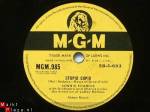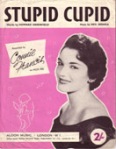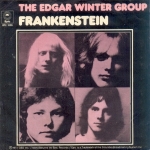 From a couple of failures came one of the biggest hits for Concetta Rosa Maria Franconero, Connie Francis. She had started out as a recording artist for MGM with little success, in fact, Connie couldn’t get a recording contract from any other label during the 1950s. In 1958, Dick Clark played Connie’s “Who’s Crying Now” on American Bandstand, and her career immediately took off. It was the beginning of one of the biggest success stories in early rock ‘n roll, and some very tragic consequences along the way.
From a couple of failures came one of the biggest hits for Concetta Rosa Maria Franconero, Connie Francis. She had started out as a recording artist for MGM with little success, in fact, Connie couldn’t get a recording contract from any other label during the 1950s. In 1958, Dick Clark played Connie’s “Who’s Crying Now” on American Bandstand, and her career immediately took off. It was the beginning of one of the biggest success stories in early rock ‘n roll, and some very tragic consequences along the way.
A set of young neighbors from Brighton Beach and famous Abraham Lincoln High School were signed to write songs for the newly formed Aldon Music label of Don Kirschner and Al Nevens. Neil Sedaka and Howard Greenfield were tasked with writing a new hit for Connie.
The Diary and Stupid Cupid
 Legend has it that Ms. Francis was summoned to the Brill Building in 1958 to find her next hit record. She was assigned to the Sedaka/Greenberg team. The two writers sang her every ballad they had written, but toward the end of the session, she began to get bored and started writing in her diary. She thought that the songs were all too sophisticated for the young generation of the day. Howard Greenberg reportedly offered to audition a song he and Sedaka had written for a different recording artist, a girl group. Sedaka was relucant, as they had already promised the song to the group. “Stupid Cupid” was finally played for Connie, and she recalls telling the young songwriting team that it would be her next hit record. She was right.
Legend has it that Ms. Francis was summoned to the Brill Building in 1958 to find her next hit record. She was assigned to the Sedaka/Greenberg team. The two writers sang her every ballad they had written, but toward the end of the session, she began to get bored and started writing in her diary. She thought that the songs were all too sophisticated for the young generation of the day. Howard Greenberg reportedly offered to audition a song he and Sedaka had written for a different recording artist, a girl group. Sedaka was relucant, as they had already promised the song to the group. “Stupid Cupid” was finally played for Connie, and she recalls telling the young songwriting team that it would be her next hit record. She was right.
Sedaka reportedly asked to see what Connie had written in her diary, she refused, and purportedly that encounter became the inspiration for his 1958 hit “The Diary.”
The Brill Building
Throughout the “Your Songs” project, you will find we refer a lot to the Brill Building and the immense influence the activity there in the late 50s and early 60s had on American Pop music. It’s difficult to tell any stories about those early doo wop and pop days without including the song “mill” that was the Brill Building. To dismiss it’s importance, regardless of how one views the musicality of the songs written there, is to ignore a significant part of music history. It would be comparable to imagining the history of rock music without “The Sound” from Philadelphia, Sun Records in Memphis or Motown.
Sedaka and Greenberg were perhaps the most successful writers to come from Aldon, there were others, and many went on to having recording careers as well, including Carol King, Neil Diamond and Paul Simon. Sedaka and Greenberg would go on to write many of Connie’s other early 60s hits from those hollowed halls in Manhattan.
America’s Sweetheart of Song
 No doubt Connie’s “Who’s Crying Now” sent the young singer on her way to becoming the most successful female act in pop music (even more successful than Madonna). But “Stupid Cupid” was the song that solidified not only her career, but the careers of Sedaka/Greenberg as songwriters, and eventually opened the door for Sedaka’s singing career as well.
No doubt Connie’s “Who’s Crying Now” sent the young singer on her way to becoming the most successful female act in pop music (even more successful than Madonna). But “Stupid Cupid” was the song that solidified not only her career, but the careers of Sedaka/Greenberg as songwriters, and eventually opened the door for Sedaka’s singing career as well.
All Music considers Connie the prototype for the female pop singers of today. Her sound at the height of her popularity was unique among female recording artists of the day. She really set the bar for what was to come for female pop artists.
From Franconero to Francis
At the young age of 10, Connie was accepted on a New York City television talent show hosted by Arthur Godfrey. He had difficulty pronouncing her last name and suggested something “easy and Irish.” Thus she became Connie Francis. That’s particularly ironic to me personally, because the same “rules” used to be given to those of us that were Radio hosts in the 60s and 70s seeking an on-air name: “easy and Irish.” I chose to buck the system and go with something easy and Dutch.
Tragic Later Life
 Though Connie enjoyed immense success in her early years, by the 1970s, her life would be shattered by a rape and later with the brutal murder of her brother. She reportedly suffers from depression to this day. But from tragedy comes success, which she was been able to amass for the past 50 years, continuing to sing to sold-out audiences.
Though Connie enjoyed immense success in her early years, by the 1970s, her life would be shattered by a rape and later with the brutal murder of her brother. She reportedly suffers from depression to this day. But from tragedy comes success, which she was been able to amass for the past 50 years, continuing to sing to sold-out audiences.
Charts
“Stupid Cupid” peaked at #14 on the Billboard Hot 100 in 1958. It is one of the slew of successful hits she released during the late 50s and early 60s, including “Where the Boys Are,” “Everybody’s Somebody’s Fool,” “Angel In The Morning” and more.
In 2001, pop singer Mandy Moore performed “Stupid Cupid” in Walt Disney’s film “The Princess Diaries.”








